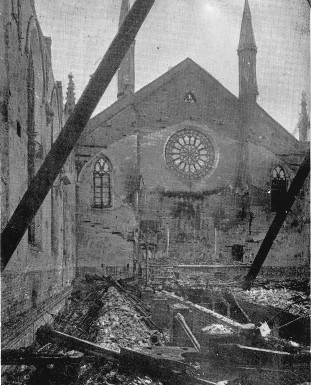

[From 'Chronicles of Portsmouth' by Henry and Julian Slight, published 1828]
"At the back of Landport Terrace, Southsea, in St. Paul's-square, on a piece of land, the free gift of Daniel and Henry Hewitt, Esqrs. stands St. Paul's Church, a noble specimen of Gothic architecture, erected by the Commissioners for building new churches, from a design of Francis Goodwin, Esq. architect. The church is in length ninety-four feet, in width sixty, exclusive of staircases, corridor, vestry etc. The exterior of the church is of Bath-stone, with four highly-ornamented turrets at the corners, eighty feet in height. The windows on the sides are of noble proportions, the frames of ornamented cast-iron. The western front adorned with a lofty window; carved niches on each side the centre doorway, with the portals of the galleries. The projecting cornices, buttresses, and turrets, exhibit a splendid specimen of the simple or plain Gothic. The eastern front is beautified in a similar manner, having an immense circular window in the centre, and projecting vestries below, and the whole is surrounded by the finest series of iron railway in Hampshire, the workmanship of Mr. Evans, erected at a cost of 400l. The interior of the fabric is plain yet elegant ; the ceiling coved, springing from each side, intersected by the pointed arches of the windows, unsupported by pillars, and adorned with suitable cornices. The galleries, which contain nine hundred free sittings for the poor, the seats for the charity children and the choir, are supported by small cast-iron Gothic pillars. In front of the west window an organ was erected by subscription in 1827. The lower part of the church is pewed, and affords accommodation for eleven hundred persons. These pews are let for the support of the officiating minister. The cost of this church was, contract price 13,814l. extras 2155ll. 13s. 2½. exclusive of the rails or palisades.
"The church was consecrated on Friday morning, Oct. 25th, 1822, by Tomline, Lord Bishop of Winchester, attended by the Chancellor and customary officers ; a grand selection of music being performed ; the Rev. L. Grant, LL.B. of New College, Oxford, who had been appointed by the vicar the first minister, officiating, and the Rev. J. H. Cumyns, sequestrator of the vicarage, preaching the sermon. The attendance on the occasion was immense. The church was opened for divine service on the Sunday following.
A fine painting of St. Paul has been placed (1827) above the communion table, by subscription of a few spirited individuals. There is great propriety and fitness in the choice of the subject, viz. the Shipwreck of St. Paul on the Island. of Melita ; and the moment seized on by the artist is that in which the Saint returns thanks to the Almighty for the wonderful deliverance. The composition of the picture is grand and simple, and tells its story plainly and distinctly. A dignified figure of Paul occupies the centre, in an attitude highly expressive of pious and grateful emotion. The ardour of his character is naturally somewhat abated, from the peculiar circumstances of the moment ; but the outstretched hand and raised countenance, in which strong confidence and deep feeling are admirably blended, well express the softened zeal and subdued intrepidity of the rescued apostle. The head is finely drawn, great delicacy is displayed in its colouring, and much force in marking the expression. The manner of the drapery is that of the old masters, full of breadth, and producing a fine variety of light and shade. The whole picture indeed evinces great knowledge in the artist, of nature, as well as of the antique : its general impression is that of sacredness and dignity. It was painted by Mr. Charles Skottowe, who has attained considerable celebrity as a portrait-painter at Cork. The picture measures nine feet by six ; the height of the figure six feet four inches.
"The bell was presented by Thomas Thistlethwaite Esq. of Southwick; and the elegant communion service of silver plate by the Rev. the Vicar. On the flagon the following inscription : Poculum hoc, cum duobus alteris, et duabus Patinis, in usum hujus Capellæ Parochialis D.D. Carolus Brune Henville, A.M. Vicarius de Portsea MDCCCXXIII."
[Further information from 'Churches, Chapels & Places of Worship on Portsea Island' by John Offord, published 1989]
St. Paul's is described by Offord as The Mother Church of Southsea, a title derived from the foundation of the church as a bastion against the non-conformist chapels 'springing up all over the inhabited parts of Portsea Island - including Southsea.' Offord goes on to comment on the architecture of the church, describing it as 'interesting' in that it had 'one of the largest single span roofs in England' and calling attention to the rose window in the East End and the four elongated pinnacles which 'seemed more akin to a Moslem Minaret.'
St. Paul's stood in it's own square with large stuccoed houses on the south side and artisans cottages on the north which were accompanied by a Baptist Chapel from 1853 which was replaced in 1908 by a "Greek Temple-like building" which was given to the church by Long, the brewer and used as a Parish Hall.
On the night of 10th/11th January 1941 the church was destroyed by German bombs with only the brass lectern somehow surviving intact. Although the parishioners made strenuous efforts to have the church rebuilt the remaining walls were eventually demolished in a general refurbishment of the whole area. Now only the name survives in St. Paul's Square.
